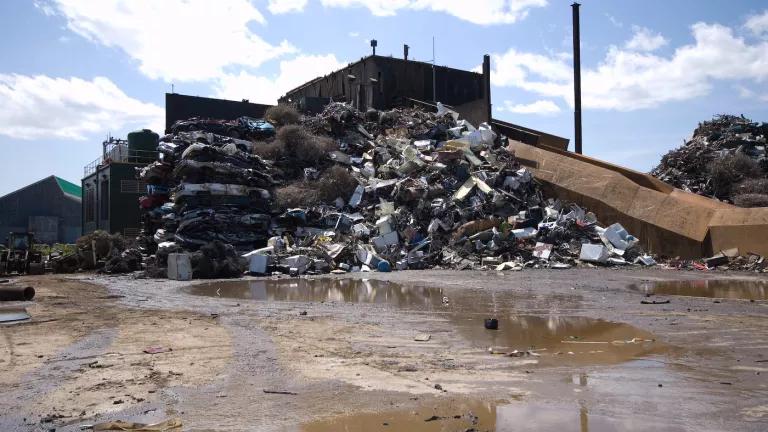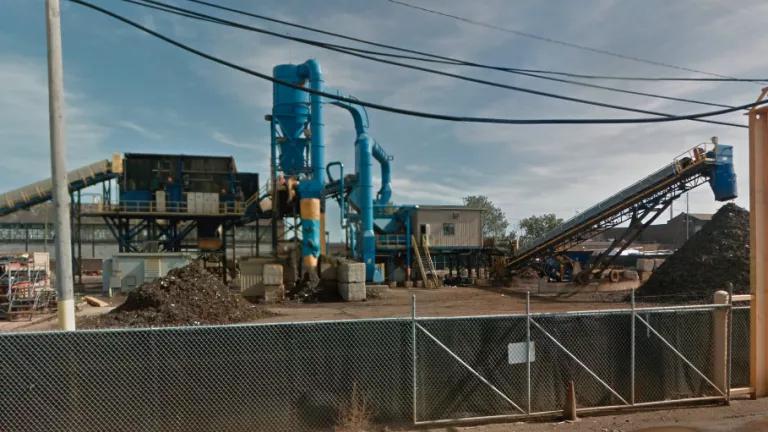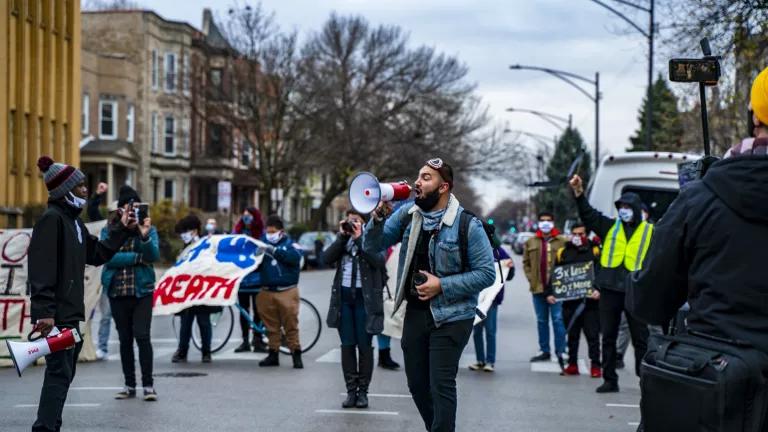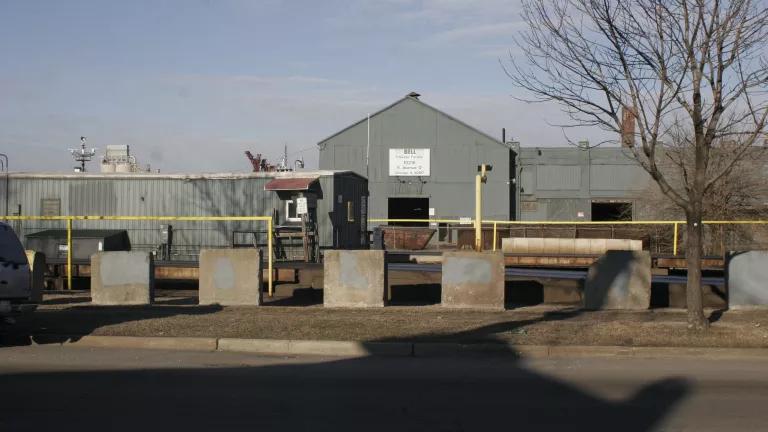Pritzker, Lightfoot: Stop Passing the Buck on Enviro Justice
On June 25, the Illinois Environmental Protection Agency (“IEPA”) granted an air permit that will enable the relocation of a notorious metal shredding operation from Chicago’s wealthy and largely white Lincoln Park to the Southeast Side environmental justice community. In doing so, both IEPA and the Governor pointed the finger at the City of Chicago for its zoning policies and decisions that they claim are the real cause of the problem.
On June 25, the Illinois Environmental Protection Agency (“IEPA”) granted an air permit that will enable the relocation of a notorious metal shredding operation from Chicago’s wealthy and largely white Lincoln Park to the Southeast Side environmental justice community. In doing so, both IEPA and the Governor pointed the finger at the City of Chicago for its zoning policies and decisions that they claim are the real cause of the problem.
IEPA’s permit approval came after community opposition flooded in, including a petition signed by nearly 7,000 people, along with letters from Alderman Susan Sadlowski-Garza and six Southside Illinois Assembly members led by Senator Robert Peters calling on Governor Pritzker and IEPA to delay and/or reject the permit. These elected officials cited the discriminatory impact of permitting the move and looked to the Governor to set an example for the state and for environmental justice.
Rather than grapple in a real way with the state’s role in creating and perpetuating environmental injustices, IEPA and Governor Pritzker claimed solidarity with environmental justice communities—but stated that the agency’s hands were tied by inadequate authority from the legislature and Illinois Pollution Control Board.
This response is emblematic of the historic vacuum in leadership on environmental justice issues within Illinois. It evidences an ongoing failure to use existing authorities to their full extent, while highlighting the ongoing gaps in laws and regulations left by years of indifference or intentional neglect at both the state and local levels. In 2020, Governor Pritzker and Mayor Lightfoot share a responsibility, and an opportunity, to finally see and hear the concerns of fenceline communities in Chicago and Illinois - rather than continuing to turn a blind eye and deaf ear to environmental justice, as their predecessors in the Governor’s mansion and City Hall have done for generations.
Here’s more on the details and how we can get on a better path to environmental justice:
The Governor’s Office is now on record calling for EJ reforms. In a strong statement of support for the concerns of environmental justice community members and their representatives, Deputy Governor Christian Mitchell responded to pressure around the IEPA’s permitting decision by committing to environmental justice reforms: “the Gov’s office agrees with the community: for too long, low income folks of color have been overburdened by pollution. And that’s why we’re going to work to change the law… So the GO will do what it has proven to be good at: research, bring together stakeholders, and work to change the law to bend it away from history and towards real environmental justice. We will engage the community and legislators, whose sincerity we do not doubt.” More on state reforms below.
IEPA is disingenuous in claiming it lacks the authority now to do a better job for this EJ community. Indeed, the agency in its own permit decision claimed to have gone beyond the legal minimum in recognition of the environmental justice implications of its action, by requiring modeling of air toxics impacts to air quality and a fugitive dust plan that isn’t expressly mandated by the state’s regulations. But when faced with in-depth legal and technical comments showing why these gestures are virtually meaningless and how IEPA could and should have gone much further, the agency balked.
- For instance, IEPA refused to recognize multiple environmental liability findings obtained against the companies through the City of Chicago’s environmental enforcement process as a basis for denying the permit. It took this position even though the Illinois Environmental Protection Act (“Act”) (and cases interpreting it) contains no such limitation, recognizes and encourages the importance of local environmental regulation and enforcement, and explicitly says the Act should be read broadly to ensure environmental protection and that polluters bear the cost of their pollution.
- Furthermore, IEPA made directly conflicting decisions regarding air quality modeling—choosing to require and rely on modeling when it supported granting the permit but refusing to do either when faced with modeling results that would weigh towards a denial. Specifically, the agency required the applicant to model impacts of lead on air quality and compare the results to the National Ambient Air Quality Standard (“NAAQS”) for lead. Both the applicant and IEPA used this analysis to claim the facility would not cause an issue with lead air quality. Our partnership took the applicant’s own modeling for air toxics and showed that the facility would produce levels of coarse particles (or “PM10”) above the NAAQS for PM10. Coarse particles are a significant issue on the Southeast Side: U.S. EPA in recent years has brought a number of enforcement actions against Southeast Side industrial facilities based on PM10 issues, including against a Koch Brother’s facility handling petcoke next to parks and homes. In response to our comment, IEPA brushed aside the PM10 modeling results by saying that the area is achieving the standard for PM10 and it had made a reasonable judgement call that there would be no PM10 problem from the facility. (Notably, the area is also achieving the lead NAAQS, but that didn’t stop IEPA from requiring the lead modeling and using the results as a basis for granting the permit.)
- IEPA also rejected our comparison of the applicant’s own modeling to a short-term health threshold for manganese used in California. Manganese is a powerful neurotoxin that has plagued the Southeast Side. In refusing to acknowledge the manganese risks shown by the applicant’s own modeling, IEPA simply said that California is the only place using this standard, without any further explaining why the short-term threshold is invalid or otherwise irrelevant.
- IEPA also refused to consider together the full emissions and impacts of the proposed new facility and the already-operating four-to-five other facilities at the site, again saying that nothing in the law or regulations requires such treatment and ignoring that the agency had the discretion to require that the sources be analyzed together at this stage.
- It similarly refused to make permit terms practicably enforceable, choosing instead to include so-called permit limits that are subjective and vague on their face and that are accompanied by little to no monitoring. This for the exact same sources that General Iron and its business partner cannot or will not control at their current facilities, like piles of auto fluff, loading barges, and trucks constantly traveling on broken and dusty pavement. The proffered reason? Nothing in the law requires IEPA to make such practicably enforceable limits (again ignoring that there is no express prohibition on IEPA requiring limits that can actually be enforced).
The result is a weak permit based on a decision steeped in arbitrariness—the hallmark of improper agency decision-making. However, Illinois state laws insulate exactly this kind of poor decision-making, as the Act only allows appeals of such state air permits by the applicant itself and not by impacted members of the public.
Which brings us to reform of state laws and regulations. While Pritzker and his agency could have done far more with their existing authority as laid out above, they are not wrong that the state’s environmental laws and regulations could and should be greatly strengthened to address environmental justice issues.
Along with adding an appeal right for impacted members of the public to challenge such decisions moving forward, the laws and regulations need to do at least the following:
- Codify IEPA’s environmental justice initiatives, which are the result of civil rights complaints filed by the Chicago Legal Clinic on behalf of members of the Chicago Environmental Justice Network, including the Southeast Environmental Task Force and the Little Village Environmental Justice Organization
- Eliminate the “automatic approval” provision in state law whereby if the IEPA fails to act on a minor source air permit application by a deadline of 90 to 180 days from receipt of a complete application, the permit is granted
- Codify the use of in-person public hearings to ensure that impacted environmental justice community members have a meaningful opportunity to be heard
- Require an environmental justice review, employing cumulative impacts analysis, of permit applications for new or expanded/modified facilities in overburdened communities, as well as renewal applications for significant facilities, and direct the agency to deny a permit where such a new or expanded/modified facility would cause or contribute to disproportionate adverse impacts on the community
We expect given their public statements on the General Iron permit that Governor and IEPA will work with EJ advocates, allies like NRDC and concerned legislators like Senator Robert Peters to ensure these changes are made as quickly as possible.
Nor are the Governor and IEPA wrong that Chicago’s zoning policies and practices are at the heart of the environmental and broader social inequities that General Iron’s move lays bare. It is these policies that created the industrial zones in the first place, and that has maintained them over the years with little to no attention on the impacted fenceline communities. It is these policies that under former-Mayor Emanuel sanctioned rezoning to push out heavy industry from the City’s North Branch and enable mega-luxury developments like Lincoln Yards, while relocating industry to “receiving” industrial zones in predominantly Black and Brown communities. So far, we have yet to see any real steps towards addressing the land use injustices inherent in these historic and more recent policies.
In the absence of such reforms, we are now calling on Mayor Lightfoot and her agencies to deny environmental approvals necessary for General Iron’s move, given the facility’s impacts on the surrounding community. And while the City has this opportunity to step up and do the right thing on General Iron, such case-by-case decisions and back-end environmental regulation cannot address the bigger picture injustices of the City’s clear policy to move dirty industry from white, wealthy communities to low-income communities of color . Mayor Lightfoot and her agencies, and City Council, must acknowledge the injustices and enact real reforms to address them. And even here Governor Pritzker and IEPA cannot pass the buck—since cities like Chicago and their zoning powers are creatures of state law, the Illinois Assembly has the power to adopt state land use legislation directing Chicago to address the environmental racism in its zoning and land use policies.
In sum, there’s a lot of work to do—and if our elected officials and agencies are genuine in their statements of support for racial equity and environmental justice in light of COVID-19 and protests following the murder of George Floyd, they will act now.




